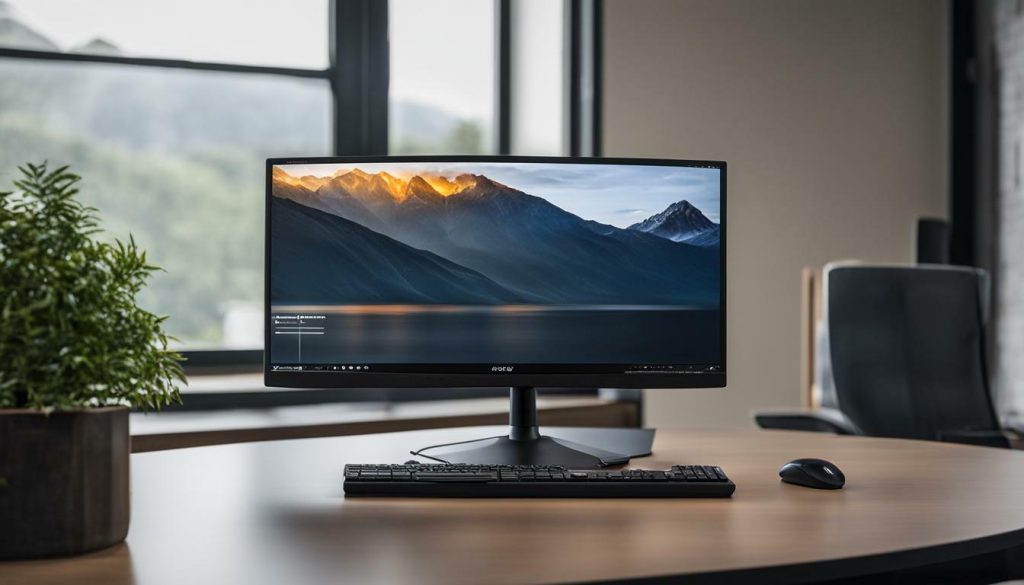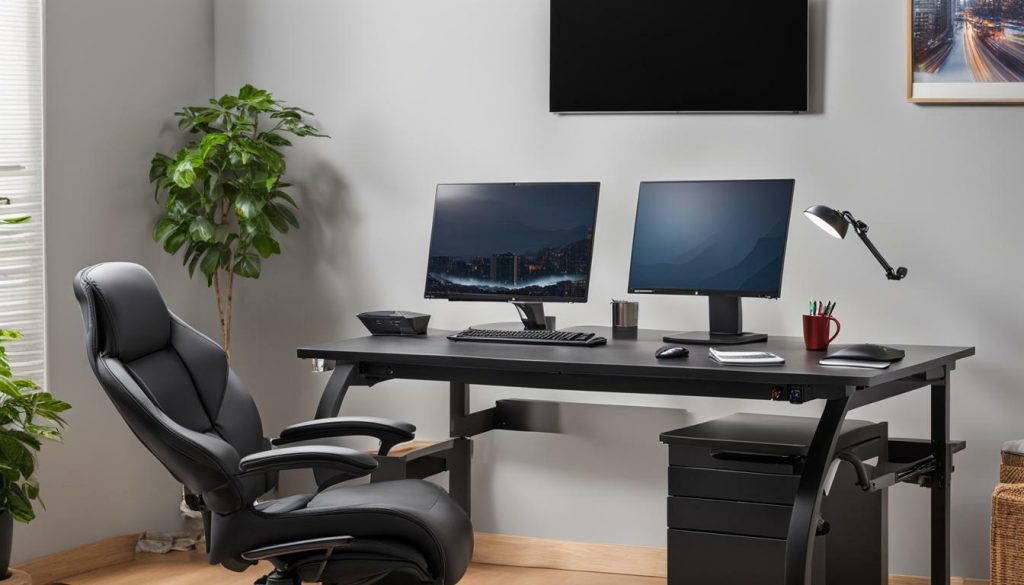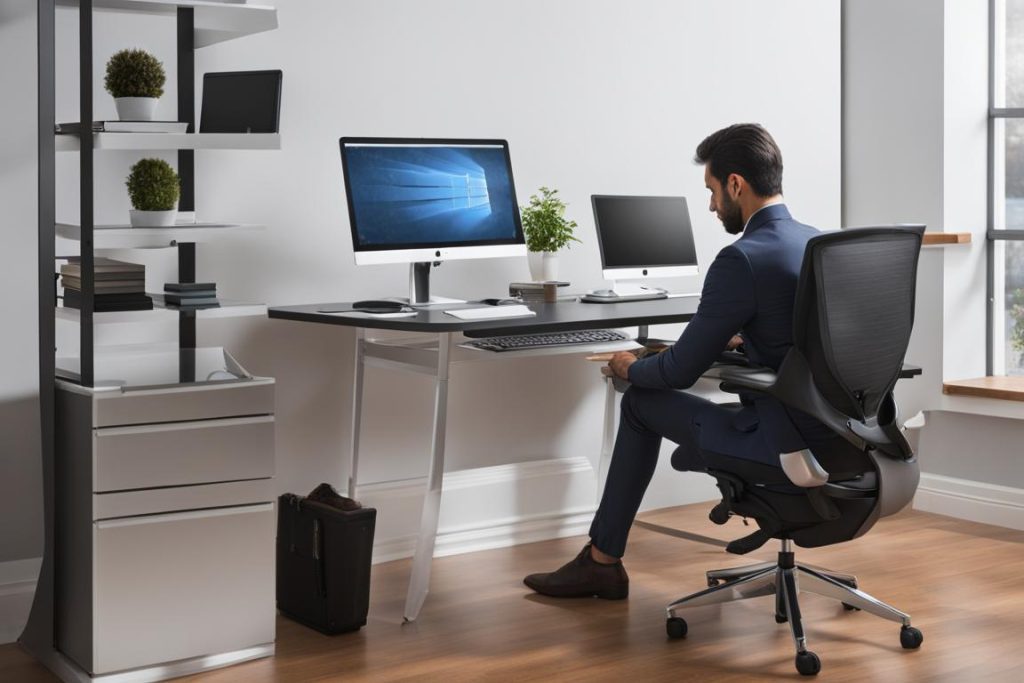Are you looking to boost your productivity and comfort at work? Discover the power of desk ergonomics and how implementing proper setups can make a significant difference in your workday.
Factual data: Unlocking your workday potential with desk ergonomics is crucial for your productivity and overall well-being. Good posture and proper body positioning can help reduce aches and pains, as well as minimize the risk of serious health problems. Sit-stand desks are recommended to optimize alertness and reduce back pain from prolonged sitting. When sitting, choosing an ergonomic chair with lumbar support and adjusting the height of your chair and desk is important. Keyboard and mouse placement should be within easy reach, and the monitor should be positioned directly in front of you at eye level. Maximizing the benefits of a sit-stand desk involves maintaining good posture, adjusting your position as necessary, choosing a reliable standing surface, and taking regular breaks. Incorporating regular movement into your work routine and setting up your workstation properly, such as adjusting monitor settings and organizing frequently used items within reach, can further enhance productivity and comfort. Different work styles may require specific desk layouts, such as ergonomic setups for computer-based work, spacious layouts for artists or designers, and flexible layouts for those who need frequent breaks. By implementing these ergonomic principles and customizing your desk layout, you can unlock your full potential and create a workspace that supports your productivity and well-being.
Key Takeaways:
- Proper desk ergonomics can significantly improve productivity and comfort at work.
- Good posture and body positioning help reduce aches, pains, and health risks.
- Sit-stand desks can optimize alertness and reduce back pain from prolonged sitting.
- An ergonomic chair with lumbar support and adjustable height is essential for sitting comfort.
- Keyboard and mouse placement should be within easy reach for efficient use.
The Impact of Desk Ergonomics on Your Well-being
Maintaining proper desk ergonomics is not just about productivity – it also plays a crucial role in safeguarding your well-being. By practicing good posture and using ergonomic office equipment, you can reduce aches and pains, and minimize the risk of serious health problems. The impact of desk ergonomics on your overall well-being cannot be overstated.
One key aspect of proper desk ergonomics is maintaining good posture. Sitting for long periods in a slouched position can lead to muscle strain in your neck, back, and shoulders. By sitting with your back straight, shoulders relaxed, and feet flat on the floor, you can reduce the strain on your muscles and joints. This not only prevents discomfort but also promotes proper alignment of your spine, reducing the risk of chronic conditions like sciatica and herniated discs.
Ergonomic office equipment also plays a vital role in supporting your well-being. Investing in an ergonomic chair with lumbar support can help maintain the natural curve of your lower back and prevent slouching. Adjustable height desks and chairs allow you to position your workstation at a comfortable height, ensuring that your arms, wrists, and hands are properly aligned as you work. This can significantly reduce the risk of developing repetitive strain injuries like carpal tunnel syndrome.


In addition to posture and ergonomic equipment, it’s important to pay attention to other factors that can impact your well-being at the desk. Proper keyboard and mouse placement can help prevent strain on your wrists and fingers. Consider using an ergonomic keyboard and mouse that promote a more natural wrist and hand position. Positioning your monitor directly in front of you at eye level can reduce eye strain and neck fatigue.
By adopting proper desk ergonomics, you are not only taking care of your immediate comfort and productivity but also investing in your long-term health and well-being. The small changes you make in your setup can have a significant impact, allowing you to work with more ease and reducing the risk of chronic pain and musculoskeletal disorders. Prioritize your well-being and unlock your true workday potential with desk ergonomics.
The Benefits of Sit-Stand Desks
Sitting for prolonged periods can lead to discomfort and back pain. Discover how sit-stand desks can help you maintain alertness and reduce the strain on your back.
One of the key benefits of sit-stand desks is their ability to promote movement and combat the negative effects of prolonged sitting. By allowing you to easily switch between sitting and standing positions throughout the day, these desks encourage a more active work routine. Studies have shown that alternating between sitting and standing can help improve blood circulation, reduce the risk of obesity, and decrease the likelihood of developing musculoskeletal disorders.
In addition to the physical benefits, sit-stand desks can also enhance your productivity and focus. When you’re standing, you’re more likely to feel energized and engaged, which can lead to increased creativity and task efficiency. The ability to adjust your desk height allows you to find the optimal position for your body, reducing strain on your back, neck, and shoulders.


Furthermore, sit-stand desks provide a customizable workspace that can be tailored to your specific needs. You have the freedom to adjust the height of your desk to suit your preference and comfort level. This flexibility allows you to find the perfect balance between sitting and standing, ensuring you can maintain focus without sacrificing your well-being.
| Benefits of Sit-Stand Desks | Summary |
|---|---|
| Promotes movement and reduces the negative effects of prolonged sitting | Enhances blood circulation and decreases the risk of obesity and musculoskeletal disorders |
| Increases productivity and focus | Boosts energy levels and creativity |
| Reduces strain on the back, neck, and shoulders | Optimizes comfort and prevents discomfort |
| Customizable workspace | Allows for personalized adjustments to suit individual needs |
Investing in a sit-stand desk can have a significant positive impact on your overall well-being and performance. It’s an investment in your health, comfort, and productivity, providing you with the tools to unlock your workday potential. By incorporating a sit-stand desk into your workspace, you can create a dynamic environment that supports your physical and mental well-being, helping you thrive in your professional endeavors.
Choosing the Right Ergonomic Chair
Your chair is a key factor in maintaining proper desk ergonomics. Find out how choosing the right ergonomic chair with lumbar support and adjustable height can make a difference in your overall comfort.
When it comes to sitting at your desk for extended periods, comfort is essential. An ergonomic chair provides the support your body needs to maintain good posture and minimize the risk of discomfort and strain. Look for a chair that offers lumbar support to help maintain the natural curve of your lower back. This support can alleviate back pain and promote better spinal alignment.
Adjustability is another important feature to consider. A chair with adjustable height allows you to position yourself at the appropriate level for your desk, ensuring that your arms are parallel to the floor and your feet are flat on the ground. This helps to prevent unnecessary strain on your shoulders, neck, and wrists.
| Features to Look for in an Ergonomic Chair |
|---|
| Lumbar support |
| Adjustable height |
| Seat depth adjustment |
| Armrest adjustability |
| Breathable fabric |
In addition to lumbar support and adjustable height, other features to consider include seat depth adjustment and armrest adjustability. Seat depth adjustment allows you to position the chair’s seat pan correctly to support your thighs without cutting off circulation. Adjustable armrests can provide support for your arms and shoulders, reducing strain on these areas.


Choosing an ergonomic chair is an investment in your comfort and well-being. It is worth taking the time to find a chair that suits your body and work style. Remember to adjust the chair to fit you properly and take regular breaks from sitting to stretch and move around. Your body will thank you for it.
Keyboard and Mouse Placement for Efficiency
Achieving optimal efficiency at your desk involves more than just having the right chair and desk setup. Discover how the placement of your keyboard and mouse can contribute to your overall comfort and productivity.
When it comes to keyboard and mouse placement, the key is to ensure that they are within easy reach and that your wrists remain in a neutral position. This will help minimize strain and prevent repetitive motion injuries. Place your keyboard directly in front of you, at a distance that allows your elbows to rest comfortably by your sides. Your wrists should be flat and in line with your forearms, avoiding excessive bending or extension.
Similarly, your mouse should be positioned next to your keyboard, at a height that allows your hand to rest comfortably. Avoid gripping the mouse too tightly or reaching for it, as this can lead to muscle tension and discomfort. Consider using an ergonomic mouse that supports a natural hand and wrist position, reducing the risk of repetitive strain injuries.
Remember, everyone’s body is unique, so it’s essential to adjust the placement of your keyboard and mouse based on your own comfort and preferences. Experiment with different positions until you find what works best for you. By optimizing the placement of your keyboard and mouse, you can enhance your comfort, reduce the risk of injury, and ultimately improve your efficiency and productivity.
Keyboard and Mouse Placement Tips:
- Position your keyboard directly in front of you, with your wrists in a neutral position.
- Place your mouse next to your keyboard, at a height that allows your hand to rest comfortably.
- Consider using an ergonomic mouse to support a natural hand and wrist position.
- Experiment with different positions to find what works best for you.
By implementing these keyboard and mouse placement tips, you can create a more ergonomic and comfortable workspace that supports your overall well-being and productivity.


Struggling with neck and eye strain while working? Learn how positioning your monitor at eye level and investing in ergonomic monitors can provide you with a comfortable and effective visual experience.
When it comes to optimizing your workspace, the position of your monitor plays a crucial role. Placing your monitor at eye level helps reduce strain on your neck and eyes, allowing for a more comfortable and productive work environment. To achieve this, make sure your monitor is positioned directly in front of you, at a height where your eyes naturally align with the top third of the screen. This alignment not only promotes proper posture but also minimizes the need for excessive neck movement and reduces the risk of developing musculoskeletal issues.
Investing in ergonomic monitors can further enhance your visual experience. These monitors are designed with adjustable stands that allow you to easily modify the height, tilt, and rotation to suit your specific preferences. By customizing the monitor’s position to match your eye level, you can create an ergonomic setup that promotes comfort and efficiency throughout your workday.


Additionally, ergonomic monitors often come with features such as anti-glare coatings and blue light filters, which help reduce eye strain caused by prolonged screen time. These features minimize the harmful effects of glare and excessive blue light emissions, allowing for a more pleasant and less fatiguing visual experience. By investing in an ergonomic monitor, you can protect your eyes and enhance your overall well-being while working.
In summary, proper positioning of your monitor at eye level is essential for reducing strain on your neck and eyes. Investing in ergonomic monitors with adjustable stands and additional features can further improve your visual experience and promote a healthier work environment. With these simple adjustments, you can unlock your workday potential and enjoy a more comfortable and productive workspace.
Maximizing the Benefits of Sit-Stand Desks
Are you making the most out of your sit-stand desk? Discover how to optimize your usage by maintaining good posture, finding the right standing surface, and taking regular breaks throughout your workday.
When it comes to using a sit-stand desk, posture plays a crucial role in reaping its benefits to the fullest. Whether sitting or standing, maintaining good posture is essential. Keep your shoulders relaxed, spine aligned, and feet planted firmly on the ground. Avoid slouching or hunching over your desk, as this can lead to fatigue and discomfort.
Choosing the right standing surface is equally important. Ensure that your desk is stable and at a suitable height for both sitting and standing. Adjust the height according to your comfort level, allowing your elbows to rest at a 90-degree angle when typing or using your mouse. This will help prevent strain on your wrists and arms, promoting a more ergonomic setup.
Remember to take regular breaks throughout your workday. Alternate between sitting and standing every 30 minutes to avoid prolonged static postures. This not only reduces the risk of musculoskeletal issues but also improves blood circulation and keeps you more alert. Use a timer or set reminders to encourage yourself to switch positions regularly.
| Benefits of Optimizing Sit-Stand Desk Usage |
|---|
| Improved posture |
| Reduced risk of back pain |
| Enhanced blood circulation |
| Increased energy and alertness |
| Boosted productivity |
By maintaining good posture, finding the right standing surface, and taking regular breaks, you can maximize the benefits of your sit-stand desk. Remember that each person’s needs may vary, so it is essential to customize the setup to suit your individual preferences and work style. Unlock your workday potential by implementing these simple yet effective ergonomic practices.


Sitting for long periods can be detrimental to your health. Find out how incorporating regular movement into your work routine and setting up your workstation properly can improve both your productivity and overall well-being.
One of the key ways to counteract the negative effects of prolonged sitting is to incorporate regular movement into your work routine. Taking short breaks every 30 minutes to stand up, stretch, and walk around can help reduce fatigue, improve blood circulation, and boost your energy levels. These breaks don’t have to be long; even a quick walk to the water cooler or a brief stretch at your desk can make a difference. Set reminders or use productivity apps to prompt you to take these movement breaks throughout the day.
When setting up your workstation, ensure that you have ample space to move around comfortably. Clear your workspace of any unnecessary clutter, and organize frequently used items within easy reach. This will allow you to move freely and access everything you need without straining or reaching too far. Consider using a standing desk or an adjustable desk converter that allows you to switch between sitting and standing positions throughout the day. This will not only encourage movement but also help alleviate back pain and reduce the risk of posture-related issues.


In addition to incorporating regular movement into your work routine, it’s important to set up your workstation properly to optimize comfort and productivity. Make sure your chair and desk are at the correct height to promote good posture. Your feet should be flat on the floor, and your knees should be at a 90-degree angle. Use an ergonomic chair with lumbar support to maintain the natural curve of your spine and alleviate pressure on your lower back. Adjust your chair’s height and the height of your desk so that your arms are comfortably positioned at a 90-degree angle when typing.
Finally, pay attention to your monitor position. Position your monitor directly in front of you at eye level to reduce strain on your neck and eyes. Adjust the brightness and contrast settings to minimize eye fatigue, and consider using an ergonomic monitor with adjustable height and tilt features for added comfort.
By incorporating regular movement into your work routine and setting up your workstation properly, you can improve your productivity, reduce the risk of musculoskeletal issues, and enhance your overall well-being. Take care of your body and create a workspace that supports your physical and mental health.
Customizing Your Desk Layout for Optimal Performance
Different work styles call for different desk layouts. Explore how you can customize your desk setup to match your specific work requirements and create a workspace that supports your productivity and well-being. Whether you are a computer-based worker, an artist or designer, or someone who needs frequent breaks, an ergonomic desk setup can greatly enhance your performance and comfort.
For computer-based work, it is essential to have a spacious layout that accommodates all your necessary equipment. Arrange your desk in a way that allows easy access to your keyboard, mouse, and other frequently used items. Consider using a cable management system to keep cords organized and prevent them from tangling. Additionally, adjust the height and angle of your monitor to reduce eye strain and ensure optimal viewing.
Artists and designers may benefit from a more expansive workspace. A flexible layout that allows you to move around freely and access your materials is key. Consider incorporating adjustable tables or drawing boards to accommodate different work positions. Have storage solutions nearby to keep your supplies organized and within reach. This will enable you to focus on your creative process without any unnecessary distractions.
Those who require frequent breaks should opt for a layout that promotes movement and comfort. Consider using a standing desk converter that allows you to switch between sitting and standing positions. This will help alleviate muscle tension and improve circulation. Additionally, create designated areas for stretching or exercise to encourage physical activity throughout the day. Remember, a well-organized and adaptable workspace can significantly enhance your overall work experience.
| Work Style | Desk Layout |
|---|---|
| Computer-based work | Spacious layout with easy access to keyboard, mouse, and monitor |
| Artistic work | Flexible layout with adjustable tables and storage solutions |
| Jobs with frequent breaks | Layout that promotes movement with standing desk converter and designated exercise areas |
By customizing your desk layout to match your specific work style, you can optimize your productivity and well-being. Remember, the right setup not only improves your physical comfort but also enhances your mental focus and efficiency. Take the time to evaluate your needs and make adjustments accordingly. With a well-designed workspace, you can unlock your full potential and achieve success in your work endeavors.


By prioritizing desk ergonomics and implementing proper setups, you can unlock your full workday potential and create a workspace that enhances both your productivity and comfort.
Good posture and proper body positioning are crucial for reducing aches, pains, and the risk of serious health problems. Incorporating sit-stand desks into your workspace can optimize alertness and minimize back pain caused by prolonged sitting. When sitting, choosing an ergonomic chair with lumbar support and adjusting the height of your chair and desk are essential.
Keyboard and mouse placement should be within easy reach, and your monitor should be positioned directly in front of you at eye level to prevent strain on your neck and eyes. Maximizing the benefits of a sit-stand desk involves maintaining good posture, adjusting your position as necessary, choosing a reliable standing surface, and taking regular breaks to avoid excessive strain.
Incorporating regular movement into your work routine and properly setting up your workstation, such as adjusting monitor settings and organizing frequently used items within reach, can further enhance productivity and comfort. Different work styles may require specific desk layouts, such as ergonomic setups for computer-based work, spacious layouts for artists or designers, and flexible layouts for those who need frequent breaks.
By implementing these ergonomic principles and customizing your desk layout to suit your needs, you can create a workspace that supports your productivity and well-being. So, don’t underestimate the importance of desk ergonomics – invest in your workday potential today!
FAQ
Q: Why is desk ergonomics important?
A: Desk ergonomics is important because it helps enhance productivity and overall well-being. It can reduce aches and pains, as well as minimize the risk of serious health problems.
Q: What is the recommended setup for a sit-stand desk?
A: When using a sit-stand desk, it is recommended to maintain good posture, adjust your position as necessary, choose a reliable standing surface, and take regular breaks to optimize the benefits of the desk.
Q: What should I consider when choosing an ergonomic chair?
A: When choosing an ergonomic chair, it is important to look for features such as lumbar support and adjustable height. These features will help provide optimal comfort and support while working.
Q: How should I position my keyboard and mouse?
A: Your keyboard and mouse should be placed within easy reach, allowing your arms to be at a comfortable and natural position. This helps prevent strain and enhance efficiency.
Q: How should I position my monitor?
A: Your monitor should be positioned directly in front of you at eye level. This ensures comfortable viewing and helps reduce strain on your neck and eyes.
Q: How can I maximize the benefits of a sit-stand desk?
A: To maximize the benefits of a sit-stand desk, it is important to maintain good posture, adjust your position as necessary, choose a reliable standing surface, and take regular breaks to avoid excessive strain.
Q: How can I incorporate movement into my work routine?
A: Incorporating regular movement into your work routine is important. You can do this by setting up your workstation to encourage movement, such as standing and stretching periodically, and taking short walks during breaks.
Q: How should I customize my desk layout?
A: The customization of your desk layout depends on your specific work style. Computer-based work may require ergonomic setups, artists or designers may need more spacious layouts, and those who need frequent breaks may benefit from flexible layouts. It’s important to tailor your workspace to your specific needs.






